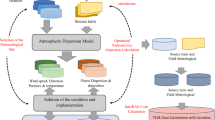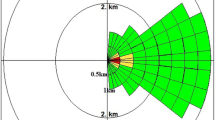Abstract
Radiological dose assessment is one of the main categories of safety assessment for nuclear reactors and facilities. The radiation risks to the public and to the environment that may arise from these facilities have to be assessed and, if necessary, controlled. The main objective of this paper is the assessment of radiation doses to residents of Tehran province after a hypothetical accident of the Tehran Research Reactor (TRR) including the determination of any protective actions that might be needed for the benefit of people’s health. The concentration of radionuclides in air and deposited on the ground surface as a result of a hypothetical radionuclide release from the TRR, following a hypothetical accident scenario, have been calculated by the HYSPLIT computer code. Simulations were performed using selected source terms taken from the TRR Final Safety Analysis Report (FSAR). Meteorological data of the Air Resources Laboratory of the National Oceanic and Atmospheric Administration (NOAA) have been used in these calculations. The simulation results indicate that maximum annual total effective dose equivalent values for the residents of the Tehran province are less than the protective action dose limits. Thus, it is concluded that during this hypothetical accident in the TRR, required safety due to public radiation is achieved and the residents of Tehran province are safe under a TRR accident condition.






Similar content being viewed by others
Notes
The compliance of potential activity concentrations in food and drinking water with the corresponding generic criteria has not been assessed in this study, thus no conclusions can be made about the need for protective actions for food and drinking water.
References
Ahangari R, Noori-Kalkhoran O, Sadeghi N (2017) Radiological dose assessment for the hypothetical severe accident of the Tehran Research Reactor and corresponding emergency response. Ann Nucl Energy 99:272–278
Arian M, Bagha N (2012) Active tectonics of Tehran area, Iran. J Basic Appl Sci Res 2(4):3805–3819
Atomic Energy Organization of Iran (2009) Safety Analysis Report for Tehran Research Reactor (SAR) vol 1, NRC-TRR-1003. Tehran, Iran
Baklanov A, Sørensen JH (2001) Parameterisation of radionuclide deposition in atmospheric long-range transport modelling. Phys Chem Earth Part B 26(10):787–799
Baklanov A, Mahura A, Jaffe D, Thaning L, Bergman R, Andres R (2002) Atmospheric transport patterns and possible consequences for the European North after a nuclear accident. J Environ Radioact 60(1–2):23–48
Draxler RR, Hess GD (1998) An overview of the HYSPLIT_4 modelling system for trajectories. Aust Meteorol Mag 47(4):295–308
Draxler RR, Hess GD (2004) Description of the HYSPLIT_4 Modeling System (NOAA Technical Memorandum ERL ARL-224). NOAA Air Resources Laboratory, Silver Spring
Eckerman KF, Ryman JC (1993) External Exposure to Radionuclides in Air, Water, and Soil: Exposure-to-dose Coefficients for General Application, Based on the 1987 Federal Radiation Protection Guidance. US Environmental Protection Agency, Office of Radiation and Indoor Air, Washington D.C.
Hanna SR, Briggs GA, Hosker RP (1982) Handbook on atmospheric diffusion (No. DOE/TIC-11223). National Oceanic and Atmospheric Administration, Oak Ridge, TN (USA). Atmospheric Turbulence and Diffusion Lab
International Atomic Energy Agency (1986) Atmospheric dispersion models for application in relation to radionuclide releases. IAEA-TECDOC-379, Vienna
International Atomic Energy Agency (1994) The Utilization of Real Time Models as a Decision Aid Following a Large Release of Radionuclides into the Atmosphere. IAEA-TECDOC-733. ISSN 1011e4289
International Atomic Energy Agency (2015) Preparedness and Response for a Nuclear or Radiological Emergency, IAEA-General Safety Requirements No. GSR Part 7, Vienna
International Commission on Radiological Protection. Task Group on Reference Man (1975) Report of the Task Group on Reference Man: A Report (Vol. 23). Pergamon Press
Kinser AM (2001) Simulating wet deposition of radiocesium from the Chernobyl accident (No. AFIT/GM/ENP/01M-05). AIR FORCE INST OF TECH WRIGHT-PATTERSON AFB OH SCHOOL OF ENGINEERING AND MANAGEMENT
Paquet F, Bailey MR, Leggett RW, Lipsztein J, Marsh J, Fell TP, Blanchardon E (2017) ICRP Publication 137: Occupational Intakes of Radionuclides: Part 3. Annals of the ICRP 46:3–4
Raza SS, Iqbal M (2005) Atmospheric dispersion modeling for an accidental release from the Pakistan Research Reactor-1 (PARR-1). Ann Nucl Energy 32(11):1157–1166
Rentai Y (2011) Atmospheric dispersion of radioactive material in radiological risk assessment and emergency response. Prog Nucl Energy 1:7–13
Zali A, Zafarghandi MS, Feghhi SA, Taherian AM (2017) Public member dose assessment of Bushehr Nuclear Power Plant under normal operation by modeling the fallout from stack using the HYSPLIT atmospheric dispersion model. J Environ Radioact 171:1–8
Author information
Authors and Affiliations
Corresponding author
Rights and permissions
About this article
Cite this article
Vali, R., Adelikhah, M.E., Feghhi, S.A.H. et al. Simulation of radionuclide atmospheric dispersion and dose assessment for inhabitants of Tehran province after a hypothetical accident of the Tehran Research Reactor. Radiat Environ Biophys 58, 119–128 (2019). https://doi.org/10.1007/s00411-018-0761-6
Received:
Accepted:
Published:
Issue Date:
DOI: https://doi.org/10.1007/s00411-018-0761-6




